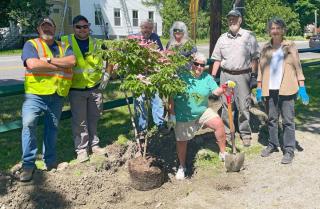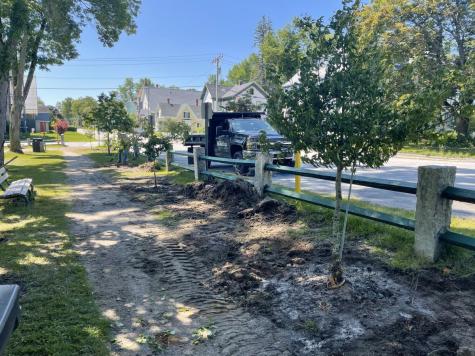City of Gardiner Receives Project Canopy Award

The City of Gardiner is pleased to announce that it has been awarded a Tree Planting and Maintenance grant of $5,732 from the Department of Agriculture, Conservation and Forestry's Project Canopy, Maine's Urban and Community Forestry Program led by the Maine Forest Service.
The City is fortunate to have received Project Canopy awards for the past three consecutive years. Funds from this year’s grant will complete the final phase of a three-year master plan established by the City’s Tree Committee to add thirty trees to the Gardiner Common. Created in response to the loss of several trees in the park over recent years, the plan includes restoring tree plantings in locations as originally planned in Gardiner’s town square.
 This last stage of the tree planting funded by Project Canopy adds ten flowering trees along the walking path which borders the park. The master tree planting plan’s goal to add tree cover to the Common will also beautify the surrounding neighborhoods and the gateway to downtown Gardiner from Route 201, reduce noise and air pollution, and provide a home for birds and small animals. Rows of healthy green trees where people can walk, or sit and relax and enjoy being outdoors will also will also contribute to the quality of life among our community.
This last stage of the tree planting funded by Project Canopy adds ten flowering trees along the walking path which borders the park. The master tree planting plan’s goal to add tree cover to the Common will also beautify the surrounding neighborhoods and the gateway to downtown Gardiner from Route 201, reduce noise and air pollution, and provide a home for birds and small animals. Rows of healthy green trees where people can walk, or sit and relax and enjoy being outdoors will also will also contribute to the quality of life among our community.
“We are very appreciative of the ability to work with the Maine Forest Service again this year,” said Andrew Carlton, Gardiner City Manager. “And for them making funding available so we can continue to beautify the City of Gardiner while at the same time not having this reach the pockets of our tax payers.”
Local funding match requirements for this grant project will be met through in-kind donations by City of Gardiner staff time and equipment usage as well as an expected 100-plus hours of donated volunteer labor. Funds from this grant will also be used to replace a tree that died at the Waterfront Park, as well as soil tests and mulch.
From soil testing and ground preparation to planting and continued watering, this project continues to be a combined effort of the City of Gardiner’s Buildings and Grounds department, the Gardiner Tree Committee, the Gardiner Rotary Club, students from the Interact Club, and several volunteers from Gardiner Main Street and the community.
To ensure the health and longevity of the plantings, all new trees are part of a three-year maintenance plan. The Project Canopy grant provides additional funds this year for a licensed arborist to help identify and address potential safety hazards among trees in public spaces, such as dead or diseased trees, which can pose a risk to public safety. The arborist would also provide expertise to ensure municipal trees are properly pruned and cared for, improving their overall health and longevity.
With these plans for care and maintenance, along with and widespread support from community members, Gardiner’s trees will be providing positive impacts on the environment and enjoyed by residents and visitors to the city for decades to come.
About Project Canopy
Project Canopy is Maine's urban and community forestry program. Its Mission is to create and maintain healthy urban and community forests for or economic, ecological, and quality of life benefits for Mainers.
Project Canopy works to keep Maine's communities green and liveable by working with municipalities and non-profits to help manage public tree resources. Through our grant program and technical assistance, we promote planting and maintaining of trees in Maine communities. Whether we support planting street trees downtown or a management plan development for town forests, Project Canopy works to help Maine communities stay leafy and green.
Project Canopy is funded by the USDA Forest Service Community Forestry Assistance Program. The USDA Forest Service Urban and Community Forestry Program was authorized by the Cooperative Forestry Assistance Act of 1978 (PL95-313) and revised by the 1990 Farm Bill (PL101-624) to promote natural resource management in populated areas and improve quality of life.
About the Gardiner Common
Originally known as Brunswick Square, this common is one of Maine’s earliest designed landscapes, and recently listed on the National Register of Historic Places. The property was donated in 1824 by Robert Gardiner, who sought to provide a public walk and parade ground while increasing the property value of his land around the park. He also wanted to improve the appearance of the town founded by his grandfather, requiring in his will that the town maintain existing rows of trees, separate walkways from roads with an ornamental fence, and add no permanent buildings. Should the town not abide by these stipulations, the three-acre site would revert to Gardiner’s heirs.
Early improvements included footpaths that cross the common and a fence made of granite bollards with wooden cross rails, which remains intact today. A Shingle-style bandstand built in the 1920s was replaced in the mid-1970s. Numerous memorials have also been added, including a Civil War memorial from 1875, the 20-foot-diameter Palmer fountain, the Stimson drinking fountain, a memorial to poet Edwin Arlington Robinson, and a war memorial honoring those lost between the Spanish-American and Vietnam wars. During World War II, the town donated the Palmer fountain’s Neptune statue and the Civil War monument’s iron fence and cannons as scrap metal; the fountain sculpture was later replaced with a contemporary design in the 1970s, the Lady and The Birds.
Today the common is bordered by churches, Greek Revival-style homes, a school, and a small commercial business. It is heavily used with a contemporary children’s playground, a perimeter walking path, and open space for public events.

